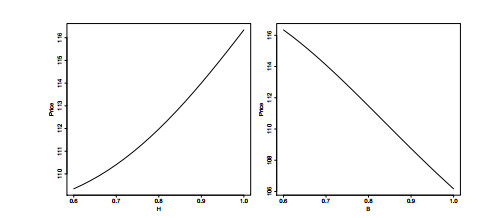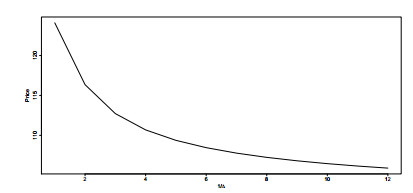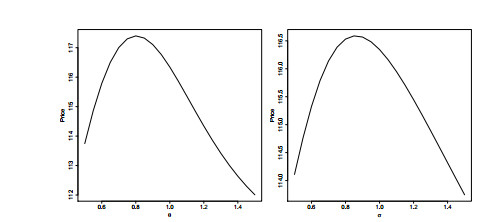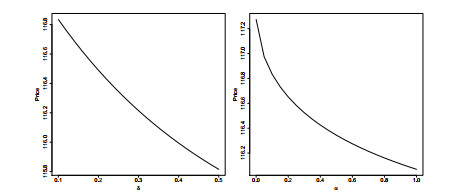In this paper we develop a new class of models for pricing autocallables based on multivariate subordinate Orstein Uhlenbeck (OU) processes. Starting from d independent OU processes and an independent d-dimensional Lévy subordinator, we construct a new process by time changing each of the OU processes with a coordinate of the Lévy subordinator. The prices of underlying assets are then modeled as an exponential function of the subordinate processes. The new models introduce state-dependent jumps in the asset prices and the dependence among jumps is governed by the Lévy measure of the d-dimensional subordinator. By employing the eigenfunction expansion technique, we are able to derive the analytical formulas for the worst-of autocallable prices. We also numerically implement a specific model and test its sensitivity to some of the key parameters of the model.
1.
Introduction
Autocallables, also known as auto-trigger structures, are very popular in the world of structure products. The autocallables generate a return based on the performance of the reference asset such as equity, commodity or currency. The reference asset can be of single-asset or multi-asset type. We focus on the latter case here as the former can be reduced from the latter. As the name suggests, the autocallable gets automatically redeemed (or autocalled) once a so-called trigger function from the asset spot prices is above the redemption level on one of several predefined observation dates (redemption dates). Usually, another trigger level, often called coupon barrier, is prespecified for each redemption date. If the autocallable does not autocall but the trigger function lies above the coupon barrier, the owner will receive a coupon. The autocallable is an exotic type of barrier option and typically treated as an option class of its own (see e.g., Bouzoubaa and Osseiran, 2010). The main reason for autocallable's growing popularity is the potential for a higher coupon, which is attractive in the current low yield environment for asset investment. Another reason is the autocallable may have a shorter lifespan than other structured products. The investors have the chance to invest in other products with the proceeds from the autocallable once it expires early.
During the period of 2007–2010, the new issuances of autocallables amount to more than 40 billion dollars in the United States (see e.g., Deng et al. (2011)). The autocallables have also been drawing an increasing amount of attention from academics in recent years. Bouzoubaa and Osseiran (2010) describe the features and payoff mechanism of single- and multi-asset autocallables as well as the risks encountered when trading these products. Fries and Joshi (2011) present a reformation of the pricing of a family of generalized autocallables through constructing a Monte Carlo scheme sampling only the survival domain of the autocallables. Alm et al. (2013) show how to adapt a Monte Carlo algorithm in such a way that its results can be stably differentiated by simple finite difference. Their new algorithm possesses a significantly reduced variance and does not require evaluation of multivariate cumulative normal distributions for pricing single- and multi-asset autocallables. Koster and Rehmet (2018) extend the idea of Glasserman (2003) to the multivariate case by means of a coordinate transform and local one-dimensional analytic treatment as in Alm et al. (2013). Their approach does not use importance sampling which has significant algorithmic advantages for the pricing of more complex autocallables or the use of path recycling for the computation of Greeks.
Besides Monte Carlo methods, analytical pricing formulas are also derived for autocallables. Deng et al. (2011) value the autocallables with continuous redemption dates using a closed-form solution based on the Back-Scholes model. Guillaume (2015a) considers two models: a two-asset Black-Scholes one and a Merton jump-diffusion framework combined with a Ho-Lee two-factor stochastic yield curve. A general, flexible form of autocallables is analytically valued under these two models. Guillaume (2015b) provides analytical formula for a general form of autocallables when the equity asset follows a jump-diffusion process, while interest rates are driven by a two-factor model.
This paper contributes to the theoretical literature on the pricing of autocallables in two directions. First, we take the modeling approach of Mendoza-Arriaga and Linetsky (2016) and construct a new model for the valuation of autocallables. Starting from d independent time-homogeneous OU processes Xi and a d-dimensional Lévy subordinator T, we construct a new process Y=(Yi), Yi=Xi(Ti(t)), by time changing each of the independent OU processes Xi with a coordinate Ti of the multivariate time change process T. The asset price Si is then modeled by taking an exponential function of Yi.
Our model belongs to a special case of multivariate subordination of Markov processes and has some distinct characteristics. First, the underlying process considered so far for the autocallables is typically geometric Brownian motion (GBM). It is well-known that GBM model does not allow for mean reversion. Instead, we build the underlying process on the OU process, which can capture mean reversion feature that is ubiquitous in various assets such as currency, commodity and even some equities. Second, time changing a continuous time Markov process such as OU process can lead to much wider class of models than the traditional jump-diffusion models. The new process can feature state-dependent mean reverting jumps with the jump direction and the jump amplitude dependent on the current state of the process. Depending on whether the time change process has drift or not, the new process will be a jump-diffusion or a pure jump process. Third, the multivariate subordination is a powerful way to construct dependence among jumps of the asset prices and the dependence is governed by the multi-dimensional Lévy measure of the subordinator. This multivariate subordination procedure enables us to model the autocallables with a basket of assets as underlying.
Second, one novelty of the paper is to derive the recursive pricing formulas for the autocallables in terms of eigenfunction expansion. The OU process belongs to a symmetric pricing semigroup, whose transition semigroup is completely analytically tractable in terms of eigenfunction expansion. The eigenvalues and eigenfunctions of the OU process are discrete and therefore, the price of the autocallables can be expressed in terms of eigenfunction expansion. A crucial advantage of eigenfunction expansion approach is that the subordinate OU process shares the same eigenfunctions with the OU process, while the eigenvalues can be easily obtained via the Laplace transform. This makes the eigenfunction expansion method very convenient for subordinate process. For an overview of the eigenfunction expansion method, we refer to Linetsky (2004) and Linetsky and Mitchell (2008). The applications of eigenfunction expansion method for the univariate subordinate processes in finance can be found in Li et al. (2017), Li and Linetsky (2014), Li et al. (2016), Lim et al. (2012), Mendoza-Arriaga et al. (2010), Mendoza-Arriaga and Linetsky (2013), Tong et al. (2019), Tong and Liu (2017) and Tong and Liu (2018). The applications of eigenfunction expansion method for the multivariate subordinate processes appear recently in Li et al. (2016) and Mendoza-Arriaga and Linetsky (2016).
The structure of the paper is as follows. In Section 2, we introduce the general model framework. Starting from d independent OU processes and a d-dimensional Lévy subordinator, we construct a new process by time changing each of the OU processes with a coordinate of the Lévy subordinator. The prices of the underlying assets of autocallables are modeled as an exponential of the subordinate processes. In Section 3, we describe the eigenfunction expansion method for both univariate and multivariate subordinate OU processes. In Section 4, we derive the recursive analytical pricing formulas for the worst-of autocallable prices using the eigenfunction expansion technique, where the expansion coefficients are also given explicitly. In Section 5, we present the numerical analysis of a specific model and provide the pricing sensitivities to some of the key parameters of the model.
2.
The model
Let (Ω,F,Q) denote a probability space with an information filtration (Ft). We assume that under the risk-neutral measure Q, the state variables Xi(t), i=1,…,d, are independent OU processes, i.e.,
where κi, θi, σi are constants. Bi(t) is a standard Brownian motion and independent of Bj(t) for i≠j.
We model the joint dynamics of asset prices Si of a basket with d components as an exponential function of a time changed OU process Yi, that is
and
where T=(T1,…,Td) is a d-dimensional time change process and Ti is the ith coordinate of T.
To introduce jumps and correlation into the asset prices dynamics, we follow Mendoza-Arriaga and Linetsky (2016) and model the time change process T as a d-dimensional Lévy subordinator; that is, each of the coordinates of T is a one-dimensional subordinator, a one-dimensional non-decreasing Lévy process starting at zero. The Laplace transform of T is given by the Lévy-Khintchine formula (see e.g., Sato, 1999). Here for ui≥0 and ⟨u,v⟩=∑ni=1uivi,
with the Laplace exponent given by
where γ∈Rd+ is the drift of the subordinator and the Lévy measure ν is a σ-finite measure on Rd concentrated on Rd+∖{0} such that
An important sub-class of multi-dimensional subordinators convenient for applications is the linear factor model (see e.g., Mendoza-Arriaga and Linetsky, 2016). Let Lk(t) be m independent one-dimensional subordinators and A a d×m matrix with non-negative entries Ai,k≥0. Define
where the coefficient Ai,k is the corresponding loading coefficient. Then the Rd+-valued T(t) is a d-dimensional subordinator with the Laplace exponent given by
where ϕk is the Laplace exponents of the m independent one-dimensional subordinators Lk. The covariance of Ti(t) and Tj(t) is determined by A:
where −ϕ″k(0)t is the variance of the kth subordinator Lk(t).
The simplest example of subordinators that belongs to the linear factor model is the single-factor model, where Ti(t)=L(t) and L is a one-dimensional Lévy subordinator. In this case, the asset prices are subordinated by the common subordinator. Since the discontinuities of the sample path of prices are due to the subordinator and the same subordinator is acting on all the processes, this implies that all the prices processes will jump together.
The second example is a two-factor model, where
where αi≥0, Li are d independent one-dimensional subordinators, which are also independent of the subordinator L. In this case, the asset prices are affected by two sources of uncertainty; one is common to all the assets and can be seen as a global uncertainty and the other is an idiosyncratic uncertainty. The presence of the idiosyncratic clock implies that the assets will not jump together.
3.
Eigenfunction expansion method for subordinate OU process
For the OU process Xi(t) defined in (1), its infinitesimal generator Li is given by
where f is transformation function. f′ and f″ are first- and second-order derivatives of f, respectively.
The infinitesimal generator Li with domain dom(Li) is always self-adjoint on the Hilbert space L2((−∞,∞),mi) of functions on (−∞,∞) square integrable with the speed measure mi(dx)=mi(x)dx and endowed with the inner product (f,g), where
and
We are interested in the transition semigroup (Pit)t≥0 of Xi defined by
We can use the eigenfunction expansion method for self-adjoint operators in Hilbert spaces to write down the spectral decomposition of Pitf(x) (see e.g., Linetsky and Mitchell, 2008).
Proposition 1. For any f∈L2((−∞,∞),mi), the transition semigroup of the OU process Xi has an eigenfunction expansion of the form
where fn=(f,ψin), {λin} are the eigenvalues of −Li and {ψin} are the corresponding eigenfunctions satisfying the following Sturm-Liouville equation
The eigenvalues and eigenfunctions of OU process can be summarized in the following result (see e.g., Linetsky and Mitchell, 2008):
Proposition 2. For the OU process Xi defined in (1), the eigenvalues λin and eigenfunction ψin, n=0,1,…, are
and
where ξi=√κiσi(x−θi),
and Hn(x) is the Hermite polynomial defined as
For the subordinate OU process Yi defined in (3), we can also compute the transition semigroup (Pi,ϕit)t≥0 of Yi, where ϕi is the Lévy exponent for the univariate Lévy subordinator Ti:
We can employ the eigenfunction expansion method again to compute the semigroup Pi,ϕitf(x) using the following result (see e.g., Li and Linetsky, 2014):
Proposition 3. For any f∈L2((−∞,∞),mi), the transition semigroup of the subordinate OU process Yi has an eigenfunction expansion of the form
where {λin} and {ψin} are the eigenvalues and eigenfunctions of OU process and can be obtained from (17) and (18), respectively.
From the above results, it is clear that a key feature of the eigenfunction expansion method is that the temporal and spatial variables are separated. The time variable t enters the expansion only through the exponential function exp(−λint). The eigenfunction expansion of time changed process Yi has the same form as the original process Xi, but with exp(−λint) replaced by exp(−ϕi(λin)t). As long as the Laplace transform of the time change process Ti is known, the time changed model will be as tractable as the original model.
For multivariate OU process X(t)=(X1(t),…,Xd(t)) and multivariate subordinate OU process Y(t)=(Y1(t),…,Yd(t)), we can define the transition semigroups of X and Y by
where x=(x1(0),…,xd(0)) and
where ϕ is the Lévy exponent for the multivariate Lévy subordinator T.
Define m(dx):=m1(dx1)…md(dxd) and ψn(x)=∏di=1ψini(xi). We can formulate the eigenfunction expansions for the semigroups Ptf(x) and Pϕtf(x) using the following results (see e.g., Mendoza-Arriaga and Linetsky, 2016).
Proposition 4. For any f∈L2((−∞,∞)d,m), the transition semigroup of the multivariate OU process X has an eigenfunction expansion of the form
where ∑n∈Zd+:=∑∞n1=0…∑∞nd=0 and
Proposition 5. For any f∈L2((−∞,∞)d,m), the transition semigroup of the multivariate subordinate OU process Y has an eigenfunction expansion of the form
where fn can be obtained from (26).
It is clear that the eigenfunction expansion of Y has the same form as X, but with exp(−∑di=1λinit) replaced by exp(−ϕ(λ1n1,⋯,λdnd)t). Thus, the eigenfunction expansion method makes the multivariate time changed model as tractable as the original model. This result explains why eigenfunction expansion method provides powerful analytical and computational tool for multivariate securities pricing.
4.
Autocallables pricing with eigenfunction expansion method
Generally, the autocallables have discrete autocall dates. Let the observation dates be 0=t0<t1<⋯<tN, where tN is the expiry date of the product. For simplicity, we assume equally discrete observations so that ti=iΔ. We consider a standard multi-asset worst-of autocallable (see e.g., Bouzoubaa and Osseiran, 2010) which pays coupons depending on the underlying basket components' worst performance reaching two triggers H (autocall trigger) and B (coupon trigger) with H≥B. The basket's worst performance at time ti is defined by
The autocallable has a payoff defined as follows:
● At each observation date ti, 1≤i<N, if WRet(tj)<H, 0<j≤i−1, and
(i) WRet(ti)≥H, then the autocallable is redeemed and the holder receives the initial notional L.
(ii) WRet(ti)≥B, then the holder receives a predetermined coupon Ci.
(iii) WRet(ti)<B, then the holder will miss the coupon and the autocallable continues.
● At expiry date tN, if WRet(tj)<H, 0<j≤N−1, and
(i) WRet(tN)≥B, then the holder receives the initial notional L plus coupon CN.
(ii) WRet(tN)<B, then the holder only gets back the notional L.
The payoff function at date ti, 1≤i≤N, can then be expressed as
Our goal is to determine the price of the autocallable with the above payoff. We will demonstrate that eigenfunction expansion method enables us to derive the analytical formulas for the autocallable price under the multivariate subordinate OU process.
Before applying eigenfunction expansion method, we notice that for our new pricing model, the eigenvalues and eigenfunctions of OU process can be calculated easily from Proposition 2. To employ the eigenfunction expansion method to calculate the autocallable price, we still need to obtain the eigenfunction expansion coefficients. In this section, we provide the formulas for several integrals that will later be employed to calculate those coefficients.
The following integrals can be computed using the results of Lim et al. (2012) and Prudnikov et al. (1986):
Lemma 1.
(i)
(ii)
where Φ(x) is the CDF of standard normal distribution.
(iii)
(iv) Define
Then, γm,n(u) can be calculated recursively as follows:
and for m≠n,
Using Lemma 1, we can also prove the following results (see also Tong et al., 2019):
Corollary 1.
(i)
(ii)
(iii)
(iv)
Using backward iteration and eigenfunction expansion method, we can obtain the analytical formula for the autocallable prices recursively. We can prove the following result:
Proposition 6. Assume that the stochastic processes for the asset prices S(t)=(S1(t),…,Sd(t)) are specified in (1), (2), (3) and the time change process T(t) is a multivariate Lévy subordinator with Lévy exponent ϕ, then the time t=0 price V(s) of an autocallable with the payoff function defined in (29), conditioning on S(0)=s=(s1,…,sd), is
where ∑n∈Zd+:=∑∞n1=0…∑∞nd=0 and ψn(log(s))=∏di=1ψini(log(si)). r is the risk-free spot rate. λini and ψini are the eigenvalues and eigenfunctions of univariate OU process Xi, respectively. The eigenfunction expansion coefficient gn1,…,nd can be obtained recursively as follows:
where
and for i=N−2,…,0,
where ϖ={1,2,…,d}. ain, bin(⋅), cim,n(⋅) and dim,n(⋅) are the functions that can be calculated using Corollary 1.
Proof. Denote V(i)(Y(ti)) the value of the autocallable at time ti=iΔ, i=0,1,…,N. Clearly, V(s)=V(0)(log(s)). At time tN,
For i=N−1, we have
where EN−1[⋅]:=E[⋅|FtN−1].
By eigenfunction expansion, we have
where using Corollary 1, we have
Therefore,
Next, we consider V(N−2)(Y(tN−2)). We have
Again using eigenfunction expansion, we obtain
where using Corollary 1, we have
We can continue this backward iteration until we reach time t0 and hence prove the result.
5.
Numerical results
In this section we report numerical results for autocallables written on a two-asset basket based on the multivariate subordinate OU model (MSub-OU). The trigger functions for the autocall and coupon payment are of worst-of type. For simplicity we let the predetermined coupon to be a deterministic function, that is Ci=L×C×Δ, where C is the coupon rate. We also specify the two-dimensional subordinator T as a linear combination of three independent subordinators Li, i=1,2,3, as follows:
and
where L1 and L2 are two idiosyncratic components to influence only the first and second asset, respectively and L3 is the systematic component common to both assets. The parameters αi, i=1,2, control the correlation between two assets. When αi=0, i=1,2, the two subordinators T1 and T2 are independent and hence, the two asset price processes S1 and S2 also become independent. The three subordinators are taken to be pure-jump driftless IG subordinators with the Lévy exponents:
where δi>0 and ηi≥0. From Tankov and Cont (2003), we know that the scale parameter δi alters the arrival rates of jumps of all sizes simultaneously, while the parameter ηi controls the decay of large jumps. The set of parameters for the benchmark model is given in Table 1. For simplicity we assume that the parameters for the two components of underlying OU processes are taking the same values. Similarly, the parameters of two idiosyncratic components of time change process are also the same. We evaluate the effect of parameter value changes on the autocallable prices by varying the selected parameters while keeping other parameters taking the values in Table 1.
In practice, to employ the eigenfunction expansion to calculate the autocallable prices, we need to truncate the eigenfunction expansion after a finite number of terms. We will follow Li et al. (2017) by truncating the infinite series when a given error tolerance level is reached. To check if our model has been implemented correctly, we plot the autocallable prices for different levels of autocall trigger H and coupon trigger B. We expect that the prices should be an increasing (decreasing) function of H (B) as the probability of hitting the autocall (coupon) trigger is a decreasing function of H (B) and therefore, the chance of missing coupon payment will be a decreasing (increasing) function of H (B). The results in Figure 1 confirm that the model behaves as expected.
In Figure 2, we also plot the sensitivities of prices to the autocall frequency 1/Δ. We find the prices decrease with the frequencies, which is due to the fact the autocallables will be less probable to stay between the coupon trigger B and autocall trigger H when the frequencies increase. When the autocallable prices go above the H or below B more often, the prices of autocallables will decrease.
We also evaluate the effect of other parameter value changes on the autocallable prices. We consider the sensitivity of autocallable prices with respect to four parameters: the long term mean parameter θ=θi and the volatility term σ=σi for the process Xi, i=1,2 and the scale parameter δ=δi and loading coefficient α=αi for the time change process Ti, i=1,2.
Figure 3 shows that the autocallable prices are an inverted U-shaped function of both θ and σ. Since the underlying state variable Xi(t) is the OU process with long term mean θ, Xi will fluctuate around θ. When θ is low, an increases in θ will decrease the chances of missing the coupons for the autocallables and therefore, the prices will increase with θ at the beginning. However, when θ becomes much larger, the probability of hitting the autocall trigger will increase as well, which will reduce the values for autocallables. When the volatility term σ is low but increases initially, the asset prices will have more chances to stay between B and H, which will increase the autocallable values. However, when σ becomes larger, an increase in σ will make the asset prices more probably go below B, which will decrease the autocallable prices.
In Figure 4, we find the autocallable prices are a decreasing function of both δ and α of the subordinators Ti. In both cases, the increases in the parameters will increase the means of Ti. In our model, the log asset prices are Xi(Ti(t)) and hence when Ti becomes larger, the asset prices will more likely take values close to the long term mean θ. In our case, the effective autocall trigger in terms of the log asset prices is log(H)+Xi(0) and according to the set of parameters given in Table 1, θ is higher than this effective trigger. As a result, the asset prices will lie above the trigger more often when the means of Ti increase and this will lower the autocallable prices.
We also compare our new model with two popular competing models. The first is an OU model without time change, which is currently one of the most popular models for the asset class with mean reversion. The OU model is nested in our model by setting Ti(t)=t, i=1,2. Note that in this model, there are no jumps in the asset prices and the assets are independent to each other. The second one is an subordinate OU model with independent time changes (Sub-OU), which is nested in our model by setting α1=α2=0. Note that in this model, the asset price processes are independent. We compare three models with varying maturities based on the parameters in Table 1. From Table 2, it is clear that the autocallable prices are increasing with maturity for each model. Furthermore, the differences in the prices across the models become larger when the maturity increases.
6.
Conclusion
This paper proposes a new modeling framework for pricing autocallables based on multivariate time changes of OU processes. Staring with d independent OU processes and time changing each of them with a coordinate of a d-dimensional Lévy subordinator, we obtain a subordinate OU processes with jumps in the product space. The dependence among jumps is governed by the Lévy measure of the d-dimensional subordinator. We then model the underlying asset prices of autocallables as an exponential function of the subordinate OU processes. We employ the eigenfunction expansion method for multivariate subordinate OU processes to derive the analytical formulas for the prices of worst-of autocallable prices. We also numerically implement our model and test its sensitivity to some of the key parameters of the underlying processes.
In practice, there are more complicated variants of autocallables such as outperformance autocallables where coupon value may be a function of the asset prices. Another complication is to add a worst-of down-and-in put feature to the autocallable structure, where the capital is no longer protected as the owner is short a put option at maturity. We need to emphasize our techniques can be extended to handle these more complex structures with minor changes and we leave these applications for future research.
Acknowledgments
This research did not receive any specific grant from funding agencies in the public, commercial, or not-for-profit sectors.
Conflict of interest
The author declares no conflicts of interest in this paper.









 DownLoad:
DownLoad:











